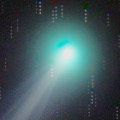
|
It approached to the sun down to 0.73 A.U. on Mar. 24, and brightened up to 4.7 mag (Mar. 11, Michael Mattiazzo). Now it is 6.7 mag (May 2, Katsumi Yoshimoto). In the Northern Hemisphere, it will be getting higher gradually, then it keeps observable in good condition while fading gradually. In the Southern Hemisphere, it keeps locating low in the morning sky after this.
Date(TT) R.A. (2000) Decl. Delta r Elong. m1 Best Time(A, h)
May 4 0 17.32 11 0.5 1.707 1.071 36 6.7 5:12 (246, 14)
May 11 0 19.00 16 43.6 1.719 1.165 41 7.0 5:17 (236, 15)
|
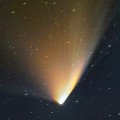
|
It passed the perihelion on Mar. 10, and brightened up to 0-1 mag. Now it is fading. But it is still bright as 7.6 mag (May 2, Katsumi Yoshimoto). In the Northern Hemisphere, it will be observable all night after May. It is not observable in the Southern Hemisphere for a while after this.
Date(TT) R.A. (2000) Decl. Delta r Elong. m1 Best Time(A, h)
May 4 0 6.60 69 45.7 1.555 1.350 59 6.9 5:12 (200,-24)
May 11 23 48.40 75 27.6 1.621 1.477 63 7.3 5:17 (192,-25)
|
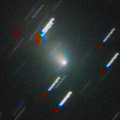
|
Now it is so bright as 9.8 mag (May 1, Chris Wyatt). It will be unobservable soon in the Northern Hemisphere. In the Southern Hemisphere, it keeps observable for a long time until the comet fades out, although it keeps locating low.
Date(TT) R.A. (2000) Decl. Delta r Elong. m1 Best Time(A, h)
May 4 5 3.06 8 58.7 2.229 1.511 34 12.0 18:40 (111, 14)
May 11 5 17.34 6 19.5 2.255 1.509 32 12.1 18:35 (108, 14)
|
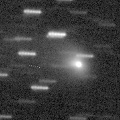
|
It brightened up to 11-12 mag in 2012. Now it is 11.8 mag (May 1, Marco Goiato). It will be observable at 12-13 mag in good condition again in 2013.
Date(TT) R.A. (2000) Decl. Delta r Elong. m1 Best Time(A, h)
May 4 14 10.17 -13 43.9 4.883 5.882 171 12.8 23:19 (180, 69)
May 11 14 1.83 -13 11.5 4.936 5.907 162 12.8 22:43 (180, 68)
|
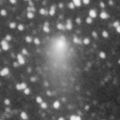
|
Now it is bright as 13.0 mag (Apr. 29, Chris Wyatt). It keeps observable at 11-13 mag for a long time from 2012 summer to 2013 summer.
Date(TT) R.A. (2000) Decl. Delta r Elong. m1 Best Time(A, h)
May 4 14 17.36 11 2.7 2.136 3.064 152 13.0 23:26 (180, 44)
May 11 14 4.71 13 30.9 2.241 3.120 144 13.2 22:46 (180, 41)
|
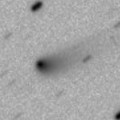
|
It brightened up to 12 mag in 2012. It is bright as 12.2 mag still now (Mar. 23, Marco Goiato). It keeps 12-14 mag until autumn. It locates somewhat low in the Northern Hemisphere.
Date(TT) R.A. (2000) Decl. Delta r Elong. m1 Best Time(A, h)
May 4 19 52.55 -26 47.0 2.446 2.925 108 13.1 5:05 (180, 82)
May 11 19 56.16 -27 21.1 2.367 2.932 114 13.0 4:41 (180, 82)
|
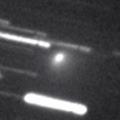
|
Now it is bright as 11.1 mag (Apr. 22, Chris Wyatt). It keeps locating in the morning sky for a long time after this. I will keep the current brightness for a long time.
Date(TT) R.A. (2000) Decl. Delta r Elong. m1 Best Time(A, h)
May 4 23 14.29 7 32.3 2.036 1.622 51 13.1 5:12 (237, 27)
May 11 23 30.78 8 32.2 2.045 1.671 54 13.3 5:17 (233, 29)
|
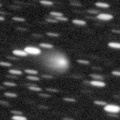
|
Now it is 13.1 mag (Apr. 20, Juan Jose Gonzalez). It keeps bright at 13-14 mag for a long time until 2014. It keeps observable for a long time in the Northern Hemisphere. It became observable also in the Southern Hemisphere.
Date(TT) R.A. (2000) Decl. Delta r Elong. m1 Best Time(A, h)
May 4 21 17.86 31 55.2 6.087 5.901 74 13.5 5:12 (198, 21)
May 11 21 15.88 32 15.9 5.997 5.900 79 13.5 5:17 (190, 22)
|
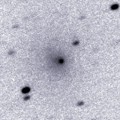
|
Now it is faint, but visible visually at 14.3 mag (Apr. 16, Alan Hale).
Date(TT) R.A. (2000) Decl. Delta r Elong. m1 Best Time(A, h)
May 4 13 47.77 -22 56.8 5.239 6.219 164 13.5 22:57 (180, 78)
May 11 13 44.80 -22 38.2 5.263 6.217 159 13.6 22:27 (180, 78)
|

|
It brightens up to 10 mag in summer. But the condition is worst and the comet will be hardly observable in this apparition. In the Northern Hemisphere, it will be observable in autumn when the comet will be fainter than 16 mag.
Date(TT) R.A. (2000) Decl. Delta r Elong. m1 Best Time(A, h)
May 4 1 48.12 4 11.4 2.287 1.365 18 14.2 5:12 (265, 0)
May 11 2 10.73 6 38.2 2.229 1.312 18 13.7 5:17 (261, 1)
|
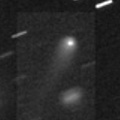
|
It keeps 13 mag and observable in good condition in the Northern Hemisphere for a long time from 2013 to 2014. Now it is 14.5 mag (Mar. 4, Sandor Szabo). It locates extremely low in the Southern Hemisphere.
Date(TT) R.A. (2000) Decl. Delta r Elong. m1 Best Time(A, h)
May 4 9 5.75 50 15.6 4.089 4.059 81 14.1 18:40 (176, 5)
May 11 9 2.32 50 17.6 4.169 4.026 74 14.1 18:35 (172, 4)
|
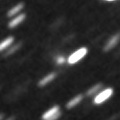
|
Now it is 14.4 mag (Apr. 13, Sandor Szabo). It will brighten up to 12 mag from summer to autumn. In the Northern Hemisphere, it will be unobservable soon. In the Southern Hemisphere, it keeps unobservable until August. Then it keeps observable while fading gradually.
Date(TT) R.A. (2000) Decl. Delta r Elong. m1 Best Time(A, h)
May 4 3 38.18 37 27.3 2.918 2.046 24 14.4 18:40 (123,-19)
May 11 3 55.38 36 4.7 2.895 1.983 20 14.3 18:35 (121,-19)
|
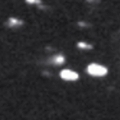
|
Now it is 15.5 mag (Apr. 13, Ken-ichi Kadota). It is expected to be a great comet in 2013 autumn when the comet approaches to the sun down to only 0.01 A.U. It keeps visible with naked eyes from November to January, and can be extremely bright as Venus or more at the highlight. It became unobservable in late May. The condition is excellent in the Northern Hemisphere. It will appear in the morning sky again in late August, then it keeps observable almost all through the period of brightening, at the highlight, and of fading. The condition is not good in the Southern Hemisphere. It is not observable at all the latter part of the highlight, and it keeps low all through the period.
Date(TT) R.A. (2000) Decl. Delta r Elong. m1 Best Time(A, h)
May 4 6 42.84 29 20.6 4.330 3.860 56 14.5 18:40 (143, 15)
May 11 6 46.08 29 4.5 4.340 3.773 50 14.5 18:35 (140, 12)
|
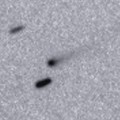
|
Now it is 14.4 mag (Apr. 30, Taras Prystavski). It keeps bright as 13-14 mag for a long time from 2013 to 2014.
Date(TT) R.A. (2000) Decl. Delta r Elong. m1 Best Time(A, h)
May 4 14 26.92 -10 10.9 2.425 3.428 172 14.6 23:36 (180, 65)
May 11 14 22.02 -10 2.2 2.426 3.414 165 14.5 23:04 (180, 65)
|
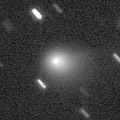
|
It brightened up to 9.0 mag in 2012 autumn (Nov. 4, Juan Jose Gonzalez). However, it faded out unexpectedly around the perihelion passage. It was expected to be 9-10 mag, but actually, it is much fainter as 13.8 mag (Apr. 16, Artyom Novichonok). In the Southern Hemisphere, it keeps observable in good condition while fading slowly after this. In the Northern Hemisphere, it is hardly observable after 2013.
Date(TT) R.A. (2000) Decl. Delta r Elong. m1 Best Time(A, h)
May 4 0 56.96 -42 50.0 2.587 2.323 63 14.6 5:12 (302, 34)
May 11 1 17.34 -42 39.7 2.602 2.376 65 14.7 5:17 (301, 36)
|
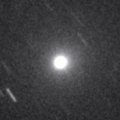
|
It brightened up to 11.0 mag in 2013 spring (Mar. 30, Juan Jose Gonzalez). Now it is fading, but still bright as 12.2 mag (May 1, Marco Goiato).
Date(TT) R.A. (2000) Decl. Delta r Elong. m1 Best Time(A, h)
May 4 10 0.71 12 17.5 1.453 1.964 104 14.6 19:12 (180, 43)
May 11 10 8.54 10 4.8 1.525 1.973 100 14.8 18:52 (180, 45)
|
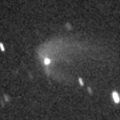
|
Big asteroid discovered in 1906. It suddenly showed the cometary activity on Dec. 11, 2010, probably due to an impact of a small object. It has already turned to be stellar. Appearing in the morning sky again in the Southern Hemisphere.
Date(TT) R.A. (2000) Decl. Delta r Elong. m1 Best Time(A, h)
May 4 23 46.50 -15 0.9 3.307 2.829 53 14.6 5:12 (263, 36)
May 11 23 55.98 -14 21.1 3.245 2.841 57 14.6 5:17 (259, 40)
|
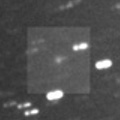
|
Now it is 15.2 mag (Mar. 30, J. F. Hernandez). It reaches up to 15 mag from spring to summer. It is observable in excellent condition in the Southern Hemisphere. It locates low in the Northern Hemisphere.
Date(TT) R.A. (2000) Decl. Delta r Elong. m1 Best Time(A, h)
May 4 14 18.79 -39 59.0 2.415 3.357 155 14.8 23:27 ( 0, 85)
May 11 14 0.43 -36 55.8 2.410 3.354 155 14.8 22:41 ( 0, 88)
|
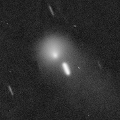
|
Now it is 14.1 mag (Mar. 5, Hidetaka Sato). It will be fading slowly after this. But it keeps 15 mag in 2013. It becomes temporarily low in May, but will be observable in good condition again after June in the Southern Hemisphere. It is not observable now in the Northern Hemisphere.
Date(TT) R.A. (2000) Decl. Delta r Elong. m1 Best Time(A, h)
May 4 3 30.85 -27 26.0 7.183 6.507 44 14.9 18:40 ( 67, 15)
May 11 3 34.83 -26 42.5 7.210 6.533 44 15.0 18:35 ( 66, 12)
|
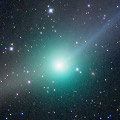
|
It kept as bright as 6-7 mag for a long time from 2011 summer to 2012 spring. Now it is fading. But it is bright as 15.2 mag still now (Mar. 4, Sandor Szabo).
Date(TT) R.A. (2000) Decl. Delta r Elong. m1 Best Time(A, h)
May 4 8 8.65 -7 20.9 5.781 5.755 83 15.0 18:40 (141, 57)
May 11 8 9.44 -7 12.8 5.947 5.816 77 15.1 18:35 (134, 54)
|
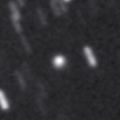
|
Now it is 15.5 mag (Apr. 20, Taras Prystavski). It is expected to brighten up to 5-6 mag in 2014 autumn. In 2013, it keeps observable in good condition until autumn when it brigthens up to 13-14 mag.
Date(TT) R.A. (2000) Decl. Delta r Elong. m1 Best Time(A, h)
May 4 17 12.32 18 39.5 5.182 5.879 129 15.3 2:26 (180, 36)
May 11 17 6.54 19 24.1 5.076 5.815 133 15.2 1:52 (180, 36)
|
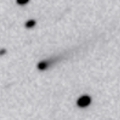
|
Now it is bright as 14.7 mag (Apr. 13, Sandor Szabo). It will be observable at 15-16 mag for a long time from 2013 to 2014.
Date(TT) R.A. (2000) Decl. Delta r Elong. m1 Best Time(A, h)
May 4 11 48.22 6 27.3 3.114 3.852 131 16.0 20:58 (180, 49)
May 11 11 47.48 6 14.7 3.188 3.847 124 16.1 20:30 (180, 49)
|
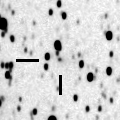
|
Now it is 17.2 mag (Apr. 11, Hidetaka Sato). It keeps 16 mag and observable in good condition until July.
Date(TT) R.A. (2000) Decl. Delta r Elong. m1 Best Time(A, h)
May 4 19 25.37 -8 26.6 1.696 2.265 111 16.2 4:38 (180, 64)
May 11 19 18.39 -3 45.5 1.600 2.258 118 16.1 4:04 (180, 59)
|
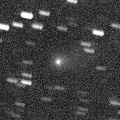
|
It brightened up to 15.5 mag in 2012 summer. Although it has already passed the perihelion, it tends to become brightest after the perihelion passage. It will be observabel at 16 mag again in 2013 summer. Now it is 18.1 mag, fainter than this ephemeris (Apr. 11, Hidetaka Sato).
Date(TT) R.A. (2000) Decl. Delta r Elong. m1 Best Time(A, h)
May 4 22 10.67 -17 51.6 3.601 3.485 75 16.4 5:12 (248, 56)
May 11 22 16.75 -17 38.8 3.520 3.500 80 16.3 5:17 (240, 61)
|
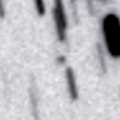
|
Now it is 17.9 mag (Apr. 4, Toshiyuki Takahashi). It is expected to brighten up to 14 mag in July and August. In the Southern Hemisphere, it keeps observable for a long time until the comet fades out. It keeps observable in good condition until September also in the Northern Hemisphere.
Date(TT) R.A. (2000) Decl. Delta r Elong. m1 Best Time(A, h)
May 4 22 5.82 22 48.0 2.921 2.665 65 16.6 5:12 (212, 25)
May 11 22 6.88 22 27.4 2.779 2.628 70 16.4 5:17 (205, 28)
|
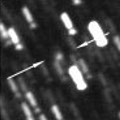
|
Now it is 16.1 mag (Mar. 4, Hidetaka Sato). In the Southern Hemisphere, it will be observable at 15-16 mag in good condition for a long time until summer. It is not observable at all in the Northern Hemisphere.
Date(TT) R.A. (2000) Decl. Delta r Elong. m1 Best Time(A, h)
May 4 3 47.38 -47 35.9 4.812 4.481 65 16.4 18:40 ( 50, 28)
May 11 3 57.85 -46 28.0 4.841 4.510 65 16.5 18:35 ( 50, 25)
|
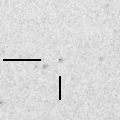
|
Now it is 17.5 mag (Mar. 16, Hidetaka Sato). It keeps observable in good condition at 17 mag from spring to summer.
Date(TT) R.A. (2000) Decl. Delta r Elong. m1 Best Time(A, h)
May 4 18 51.78 -11 0.1 2.266 2.903 119 16.6 4:05 (180, 66)
May 11 18 53.24 -10 7.0 2.198 2.906 125 16.5 3:39 (180, 65)
|
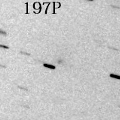
|
Now it is unusually bright in outburst. It was faint as 18.5 mag on Apr. 10, but brightened up to 16.1 mag on Apr. 16 (Hidetaka Sato).
Date(TT) R.A. (2000) Decl. Delta r Elong. m1 Best Time(A, h)
May 4 23 35.44 -22 7.2 1.307 1.184 59 16.7 5:12 (270, 42)
May 11 23 59.83 -21 27.0 1.334 1.225 61 17.1 5:17 (268, 43)
|
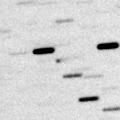
|
Now it is 16.6 mag (Apr. 2, Hidetaka Sato). It will be fading after this, and will be fainter than 18 mag in June.
Date(TT) R.A. (2000) Decl. Delta r Elong. m1 Best Time(A, h)
May 4 21 29.08 -6 17.9 1.531 1.697 81 16.8 5:12 (221, 55)
May 11 21 41.42 -5 26.7 1.500 1.727 84 17.0 5:17 (212, 56)
|
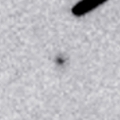
|
It is expected to brighten up to 11 mag and become observable in excellent condition in 2014 spring. Now it is 16.8 mag (Apr. 17, A. Klotz, F. Kugel, J. Caron). In the Northern Hemisphere, it keeps observable in good condition until early summer. It locates low in the Southern Hemisphere.
Date(TT) R.A. (2000) Decl. Delta r Elong. m1 Best Time(A, h)
May 4 8 37.31 40 28.1 3.941 3.868 78 16.9 18:40 (170, 14)
May 11 8 40.98 40 13.0 3.974 3.802 72 16.8 18:35 (166, 13)
|
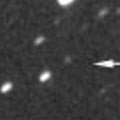
|
Now it is 18.3 mag (Apr. 11, Hidetaka Sato). It is expected to be observable at 16 mag in good condition in summer and autumn. But it is fainter than predicted recently.
Date(TT) R.A. (2000) Decl. Delta r Elong. m1 Best Time(A, h)
May 4 22 23.70 8 40.1 2.387 2.143 63 17.0 5:12 (225, 35)
May 11 22 36.30 10 10.5 2.322 2.137 66 17.0 5:17 (219, 36)
|

|
First return of a new periodic comet discovered in 2005. It will be observable at 17 mag for a long time from 2013 to 2014. However, it has not been recovered yet. Not it is fainter than 19.5 mag (Feb. 21, Martin Masek).
Date(TT) R.A. (2000) Decl. Delta r Elong. m1 Best Time(A, h)
May 4 17 21.46 -13 22.3 2.428 3.282 141 17.2 2:35 (180, 68)
May 11 17 18.87 -13 10.9 2.367 3.274 148 17.2 2:05 (180, 68)
|
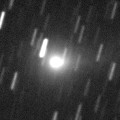
|
Long-lost comet for almost 200 years since 1827. Finally re-discovered by Rob Matson from SWAN images of mid November. Now it is fading, but still bright as 14.1 mag (Apr. 30, Taras Prystavski). In the Northern Hemisphere, it keeps observable in excellent condition while fading after this. In the Southern Hemisphere, it keeps locating extremely low after this.
Date(TT) R.A. (2000) Decl. Delta r Elong. m1 Best Time(A, h)
May 4 11 48.10 48 31.1 1.854 2.323 104 17.2 20:57 (180, 7)
May 11 11 30.75 45 50.3 2.034 2.411 99 17.7 20:12 (180, 9)
|
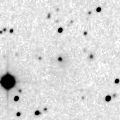
|
New comet. Now it is 16.7 mag (Apr. 8, Siding Spring Survey). It will be fading after this. It locates low in the Northern Hempshere.
Date(TT) R.A. (2000) Decl. Delta r Elong. m1 Best Time(A, h)
May 4 20 4.25 -33 37.9 2.280 2.748 106 17.2 5:12 (218, 88)
May 11 19 53.91 -32 20.5 2.210 2.797 115 17.2 4:39 (180, 87)
|

|
It was observed around 20 mag in 2012 spring. But it has not been observed recently. It will be observable at 17.5 mag from spring to summer.
Date(TT) R.A. (2000) Decl. Delta r Elong. m1 Best Time(A, h)
May 4 18 29.90 -19 22.5 1.920 2.645 126 17.4 3:43 (180, 74)
May 11 18 30.00 -18 36.7 1.858 2.652 132 17.3 3:15 (180, 74)
|
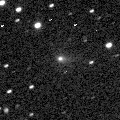
|
Now it is bright as 15.8 mag (Apr. 10, Catalina Sky Survey). It keeps observable in good condition at 16-17 mag until June. It locates somewhat low in the Southern Hemisphere.
Date(TT) R.A. (2000) Decl. Delta r Elong. m1 Best Time(A, h)
May 4 9 36.90 20 7.9 1.564 1.953 96 17.4 18:48 (180, 35)
May 11 9 47.73 19 16.3 1.626 1.949 92 17.5 18:35 (179, 36)
|
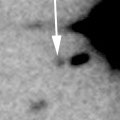
|
Now it is 17.0 mag (Mar. 4, Hidetaka Sato). It keeps 17 mag for a long time from 2012 to 2013, and will be observable in good condition in the Southern Hemisphere. It is not observable at all in the Northern Hemisphere.
Date(TT) R.A. (2000) Decl. Delta r Elong. m1 Best Time(A, h)
May 4 2 5.60 -61 4.3 5.008 4.887 77 17.4 5:12 (326, 29)
May 11 2 8.78 -61 18.8 4.966 4.895 80 17.4 5:17 (325, 33)
|
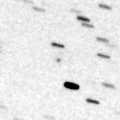
|
New comet. Now it is 18.1 mag (Apr. 20, P. C. Sherrod). It brightens up to 17.5 mag in May and June.
Date(TT) R.A. (2000) Decl. Delta r Elong. m1 Best Time(A, h)
May 4 14 55.97 -15 38.2 1.263 2.271 177 17.6 0:11 (180, 71)
May 11 14 17.79 -16 59.3 1.241 2.237 167 17.5 22:57 (180, 72)
|
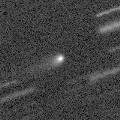
|
Now it is 17.4 mag (Apr. 17, M. Brusa, L. Sempio). It brightened up to 16.5 mag in 2012. It will be observable in good condition again at 17.5 mag in 2013 spring.
Date(TT) R.A. (2000) Decl. Delta r Elong. m1 Best Time(A, h)
May 4 12 46.98 9 37.5 5.343 6.163 141 17.5 21:56 (180, 45)
May 11 12 40.33 9 51.2 5.444 6.183 133 17.6 21:22 (180, 45)
|

|
It has not been observed yet in this apparition. But it must have been already brightened up to 18 mag. It is expected to be bright as 16 mag and observable in good condition from summer to autumn.
Date(TT) R.A. (2000) Decl. Delta r Elong. m1 Best Time(A, h)
May 4 22 20.03 -9 47.8 1.729 1.681 70 17.9 5:12 (240, 49)
May 11 22 39.30 -7 48.1 1.646 1.641 71 17.7 5:17 (235, 50)
|

|
Peculiar asteroid discovered in 2009. It was observed only during 9 days, then it became lost. In calculation, it passes the perihelion in 2014 July and brightens up to 17 mag.
Date(TT) R.A. (2000) Decl. Delta r Elong. m1 Best Time(A, h)
May 4 16 30.50 -22 13.9 3.938 4.865 154 17.9 1:44 (180, 77)
May 11 16 27.60 -22 9.5 3.875 4.844 161 17.8 1:14 (180, 77)
|
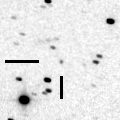
|
New comet. Now it is 17.3 mag (Apr. 16, Siding Spring Survey). It keeps 17-18 mag for a long time from 2013 to 2014. It keeps observable in good condition in the Southern Hemisphere. In the Northern Hemisphere, it is only observable until 2012 July.
Date(TT) R.A. (2000) Decl. Delta r Elong. m1 Best Time(A, h)
May 4 15 13.65 -15 29.6 4.308 5.310 172 17.9 0:28 (180, 71)
May 11 15 5.32 -15 51.5 4.276 5.285 177 17.9 23:47 (180, 71)
|
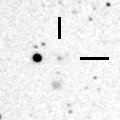
|
New comet. Now it is 17.8 mag (Apr. 21, Catalina Sky Survey). It brightens up to 18 mag at best in May and June.
Date(TT) R.A. (2000) Decl. Delta r Elong. m1 Best Time(A, h)
May 4 15 0.34 15 40.1 1.729 2.639 148 17.9 0:14 (180, 39)
May 11 14 56.10 14 39.2 1.725 2.632 147 17.9 23:38 (180, 40)
|
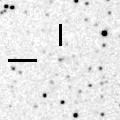
|
New comet. Now it is 18.2 mag (Apr. 16, Hidetaka Sato). It keeps 18 mag for a long time from 2013 to 2014.
Date(TT) R.A. (2000) Decl. Delta r Elong. m1 Best Time(A, h)
May 4 15 30.39 -17 38.8 2.658 3.652 168 17.9 0:44 (180, 73)
May 11 15 26.73 -17 15.7 2.628 3.636 176 17.9 0:13 (180, 72)
|
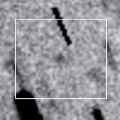
|
It was predicted to be already 15-16 mag. But actually, it is 19.3 mag, much fainter than predicted by 4 mag (Apr. 23, Mt. Lemmon Surveyr). It was expected to brighten up to 14 mag and to be observable in excellent condition in summer. However, it can be fainter than 18 mag.
Date(TT) R.A. (2000) Decl. Delta r Elong. m1 Best Time(A, h)
May 4 15 15.28 3 27.7 0.929 1.905 159 19.4 0:29 (180, 52)
May 11 15 11.07 3 41.7 0.898 1.875 158 19.2 23:53 (180, 51)
|
|
![]()
 C/2011 J2 ( LINEAR )
C/2011 J2 ( LINEAR ) C/2012 V2 ( LINEAR )
C/2012 V2 ( LINEAR ) C/2012 S1 ( ISON )
C/2012 S1 ( ISON ) 117P/Helin-Roman-Alu 1
117P/Helin-Roman-Alu 1 C/2011 F1 ( LINEAR )
C/2011 F1 ( LINEAR ) 63P/Wild 1
63P/Wild 1 (596) Scheila
(596) Scheila C/2012 K6 ( McNaught )
C/2012 K6 ( McNaught ) C/2009 F4 ( McNaught )
C/2009 F4 ( McNaught ) C/2009 P1 ( Garradd )
C/2009 P1 ( Garradd ) C/2012 K1 ( PanSTARRS )
C/2012 K1 ( PanSTARRS ) P/2012 B1 ( PanSTARRS )
P/2012 B1 ( PanSTARRS ) C/2013 F3 ( McNaught )
C/2013 F3 ( McNaught ) 152P/Helin-Lawrence
152P/Helin-Lawrence C/2012 S3 ( PanSTARRS )
C/2012 S3 ( PanSTARRS ) C/2011 O1 ( LINEAR )
C/2011 O1 ( LINEAR ) P/2012 F2 ( PanSTARRS )
P/2012 F2 ( PanSTARRS ) 197P/LINEAR
197P/LINEAR 125P/Spacewatch
125P/Spacewatch C/2012 X1 ( LINEAR )
C/2012 X1 ( LINEAR ) 257P/2012 F4 ( Catalina )
257P/2012 F4 ( Catalina ) P/2005 L1 ( McNaught )
P/2005 L1 ( McNaught ) 273P/2012 V4 ( Pons-Gambart )
273P/2012 V4 ( Pons-Gambart ) C/2013 G2 ( McNaught )
C/2013 G2 ( McNaught ) 91P/Russell 3
91P/Russell 3 175P/Hergenrother
175P/Hergenrother C/2012 C1 ( McNaught )
C/2012 C1 ( McNaught ) C/2013 G6 ( Lemmon )
C/2013 G6 ( Lemmon ) C/2010 R1 ( LINEAR )
C/2010 R1 ( LINEAR ) 184P/Lovas 2
184P/Lovas 2 2009 DL26
2009 DL26 C/2013 G7 ( McNaught )
C/2013 G7 ( McNaught ) C/2013 H1 ( La Sagra )
C/2013 H1 ( La Sagra ) P/2013 G1 ( Kowalski )
P/2013 G1 ( Kowalski ) 98P/Takamizawa
98P/Takamizawa![]()







































